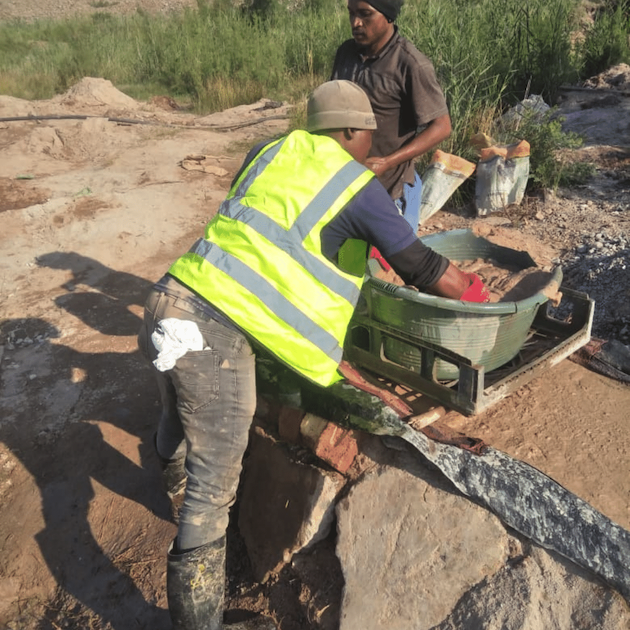[ad_1]

JOHANNESBURG, Mar 24 (IPS) – Greed, poverty, irresponsible authorized mining giants which exploited after which deserted South Africa’s mines, along with the federal government’s failure to implement rules on the mining giants to rehabilitate mines earlier than closing them, have created fertile floor for a thriving unlawful artisanal mining sector known as Zama Zama, lots of them run by prison syndicates.
South Africa’s financial system has largely been mining based mostly, and beneath apartheid, white-owned mining corporations exploiting profitable gold, diamond, coal, and chrome grew wealthy, utilizing low-cost native and migrant labour from neighbouring nations.
Publish-apartheid, the ANC authorities has tried to convey black possession and small-scale miners into the mining sector and, extra not too long ago, tried to decriminalise artisanal miners who use rudimentary instruments and are largely concerned in floor mining.
In keeping with submissions made by the Authorized Sources Centre (LRC), the Benchmarks Basis, and the Worldwide Labour Analysis and Info Group (ILRIG), coverage weaknesses, lack of enforcement, bureaucratic bungling, and crimson tape have ensured that the established order from apartheid stays largely intact.
The LRC contends that retrenchments as a consequence of mechanisation or closure of unprofitable mines have elevated unlawful mining. The dearth of enforcement of legal guidelines regarding the rehabilitation of closed mines has created area for prison Zama Zama and artisanal miners who’re perforce unlawful to function in disused or deserted mines.

With the publishing of the Coverage on Artisanal and Small-Scale Mining in March 2022, artisanal miners everywhere in the nation are forming cooperatives in a bid to be legalised. However it’s an uphill battle to get permits.
The LRC additionally warns of additional battle and xenophobia as a result of the regulation precludes overseas Zama Zama from getting permits. Nonetheless, Minister of Mineral Sources and Power Gwede Mantashe says: “It have to be clear that after a person illegally enters our nation and engages in unlawful financial exercise, such a person can’t be sanitised by way of being issued with a small-scale mining license.”
Robert Krause, an environmental researcher, says that the roots of the issue lie in “the mining homes shirking their environmental rehabilitation tasks in addition to failure to spend money on a post-mining financial system for staff and the encircling neighborhood.”
There are almost 6000 ownerless and derelict mines, lots of them “deserted by mining capital earlier than the current regulatory dispensation beneath the Nationwide Environmental Administration Act and the Monetary Provisioning rules.”
Krause says there’s “a persisting sample of huge mining homes promoting off their mines in the direction of closure to corporations they know full properly won’t be able to hold out their rehabilitation duties.”
Authorized loopholes and lax regulation by the regulator allow this.
“The businesses that find yourself with liabilities steadily go bancrupt, and the monetary provision for closure is commonly handled as simply one other declare.”
He says, “Mine abandonment fuels unlawful or artisanal operations, as low-grade ore is left behind, handy entrances stay open, and folks in want of labor are thrown out of the financial system.”
When the worthwhile reserves are depleted, there’s an employment disaster. Then, the choice for survival, primarily the place closure will not be completed correctly, is to grow to be a Zama Zama.
Krause says the artisanal miners want materials help and capacitation from mining corporations and the state, “as a substitute they’re nonetheless usually handled like criminals whereas violent prison syndicates flourish.”
In keeping with an Oxpeckers setting journalism probe a number of years in the past, “a fortune has been put aside for mine rehabilitation in South Africa. However giant mines usually are not being correctly closed, and the cash can’t be touched.”
Oxpeckers say that though the cash can’t be used for rehabilitation whereas a mine remains to be operational, the DMRE can use it whether it is deserted.
“The division is but to supply an occasion by which this cash has been used, nonetheless. As an alternative, most mines usually are not deemed legally closed, and the cash can’t be touched.”
However Mantashe says: “It’s estimated that it could price over R49 billion to rehabilitate these mines. The Division of Mineral Sources and Power (DMRE) receives R140 million every year for the rehabilitation of mines. With this allocation, we are able to solely rehabilitate no less than three mines and seal off 40 shafts per 12 months.”
The minister revealed in September 2022 that 135 shafts within the Jap, Central, and Western Basins in Gauteng (province) have been sealed over three years. The DMRE supposed to seal off one other 20 within the present monetary 12 months, prioritising the Krugersdorp space the place Zama Zama gang raped a movie crew in July final 12 months.
Mantashe says that the rehabilitation of mines is a protracted phrases challenge: “We should recognize that it could take a very long time to utterly rehabilitate all these mines at this price as a consequence of finances constraints and safety threats to officers executing this programme.”
Advocates for the legalisation of artisanal miners say the federal government wants to supply sources to fund environmental assessments and facilitate an area consumers’ market by way of a nationwide shopping for entity to promote their mined merchandise.
“Individuals in South Africa have to lastly see the advantages of the mineral sources of South Africa, as previously colonial and Apartheid practices coupled with large-scale mining have disadvantaged nearly all of this profit,” the LRC group says.
Clearly, it is a pipe dream, because the wrestle by artisanal miners to get permits to grow to be authorized has underlined.
The irony is that their legalisation won’t solely enable them to earn a residing but additionally pay taxes and finish their fixed harassment by prison components and the police alike.
IPS UN Bureau Report
Follow @IPSNewsUNBureau
Follow IPS News UN Bureau on Instagram
© Inter Press Service (2023) — All Rights ReservedOriginal source: Inter Press Service
[ad_2]

